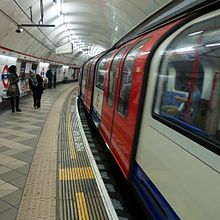It has been suggested that Platform gap filler be merged into this article. (Discuss) Proposed since October 2024. |

A platform gap (also known technically as the platform train interface or PTI in some countries) is the space between a train car (or other mass transit vehicle) and the edge of the station platform, often created by geometric constraints, historic legacies, or use of partially compatible equipment.[1]
Many high-quality bus rapid transit (BRT) systems also use high platforms at station stops to allow fast and efficient level boarding and alighting, but potentially leaving hazardous gaps between the platforms and the buses. Alignment setups such as Kassel curbs help to reduce platform gaps without requiring time-consuming manual alignment at each BRT station stop.
- ^ The Engineering Handbook of Smart Technology for Aging, Disability and Independence, Page 563